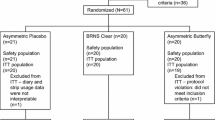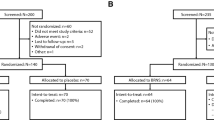Abstract
To test the impact of nasal dilator strips (NDSs) on insomnia severity, sleep-disordered breathing (SDB) symptoms, sleep quality, and quality of life. Randomized, controlled trial of 4 weeks' duration. Community sample of nonobese, adults with a primary sleep complaint of chronic sleep-maintenance insomnia and mild to moderate SDB symptoms (treatment, n=42; control, n=38). Primary outcomes were four validated scales: Insomnia Severity Index (ISI), Pittsburgh Sleep Quality Index (PSQI), Functional Outcomes of Sleep Questionnaire (FOSQ), and Quality of Life Enjoyment and Satisfaction Questionnaire (QLESQ). Secondary outcomes were sleep indices, nonrestorative sleep ratings, and SDB symptoms, assessed retrospectively and prospectively. Both groups received nonspecific education about sleep disorders. Treatment group also received a brief SDB education and nasal strip instructions. At 4 weeks' follow-up, the treatment group demonstrated significant (p=.0001), large improvements in ISI and PSQI (mean Cohen's d=1.18) and significant (p<.02), medium-sized improvements in FOSQ and QLESQ (mean d=0.51) compared to small, nonsignificant changes in control group (Cohen's d range=0.36–0.09). Treatment group change scores among all four primary variables were significantly correlated (mean r=0.50, p=0.01). Secondary prospective and retrospective outcomes showed medium to large improvements in treatment compared to controls for sleep indices (mean d=0.52 vs 0.28), nonrestorative sleep ratings (mean d=0.69 vs 0.11), and sleep breathing symptoms (mean d=0.47 vs 0.09). Significance was obtained for prospective sleep indices (p=0.01), retrospective, and prospective nonrestorative sleep ratings (p=0.003, <0.05), and retrospective sleep breathing symptoms (p=0.03). SDB education and NDSs demonstrated therapeutic efficacy in a select sample of insomnia patients with SDB symptoms. Replication of results requires placebo controls and objectively confirmed SDB cases.



Similar content being viewed by others
References
Guilleminault C, Eldridge FL, Dement WC (1973) Insomnia with sleep apnea: a new syndrome. Science 181(102):856–858
Krakow B, Melendrez D, Ferreira E et al (2001) Prevalence of insomnia symptoms in patients with sleep-disordered breathing. Chest 120(6):1923–1929
Smith S, Sullivan K, Hopkins W et al (2004) Frequency of insomnia report in patients with obstructive sleep apnoea hypopnea syndrome (OSAHS). Sleep Med 5(5):449–456
Krakow B (2004) An emerging interdisciplinary sleep medicine perspective on the high prevalence of co-morbid sleep-disordered breathing and insomnia. Sleep Med 5(5):431–433
Krakow B, Melendrez D, Pedersen B et al (2001) Complex insomnia: insomnia and sleep-disordered breathing in a consecutive series of crime victims with nightmares and PTSD. Biol Psychiatry 49(11):948–953
Krakow B, Melendrez D, Johnston L et al (2002) Sleep-disordered breathing, psychiatric distress, and quality of life impairment in sexual assault survivors. J Nerv Ment Dis 190(7):442–452
Guilleminault C, Palombini L, Poyares D et al (2002) Chronic insomnia, postmenopausal women, and sleep disordered breathing: part 1. Frequency of sleep disordered breathing in a cohort. J Psychosom Res 53(1):611–615
Gold AR, Dipalo F, Gold MS et al (2003) The symptoms and signs of upper airway resistance syndrome: a link to the functional somatic syndromes. Chest 123(1):87–95
Krakow B, Haynes PL, Warner TD et al (2004) Nightmares, insomnia, and sleep-disordered breathing in fire evacuees seeking treatment for posttraumatic sleep disturbance. J Trauma Stress 17:257–268
Gold AR, Dipalo F, Gold MS et al (2004) Inspiratory airflow dynamics during sleep in women with fibromyalgia. Sleep 27:459–466
Chung KF, Krakow B, Melendrez DC et al (2003) Relationships between insomnia and sleep-disordered breathing. Chest 123:310–313
Guilleminault C, Stoohs R, Kim YD et al (1995) Upper airway sleep-disordered breathing in women. Ann Intern Med 122(7):493–501
Lavie P, Gertner R, Zomer J et al (1981) Breathing disorders in sleep associated with “microarousals” in patients with allergic rhinitis. Acta Otolaryngol 92(5–6):529–533
Staevska MT, Mandajieva MA, Dimitrov VD (2004) Rhinitis and sleep apnea. Curr Allergy Asthma Rep 4(3):193–199
Guilleminault C, Palombini L, Poyares D et al (2002) Chronic insomnia, premenopausal women and sleep disordered breathing: part 2. Comparison of nondrug treatment trials in normal breathing and UARS post menopausal women complaining of chronic insomnia. J Psychosom Res 53(1):617–623
Ferguson BJ (2004) Influences of allergic rhinitis on sleep. Otolaryngol Head Neck Surg 130:617–629
Rappai M, Collop N, Kemp S et al (2003) The nose and sleep-disordered breathing: what we know and what we do not know. Chest 124(6):2309–2323
Krakow B, Melendrez D, Sisley B et al (2004) Nasal dilator strip therapy for chronic sleep maintenance insomnia: a case series. Sleep Breath 8(3):133–140
Scharf MB, Brannen DE, McDannold M (1994) A subjective evaluation of a nasal dilator on sleep and snoring. Ear Nose Throat J 73(6):395–401
Turnbull GL, Rundell OH, Rayburn WF et al (1996) Managing pregnancy-related nocturnal nasal congestion. The external nasal dilator. J Reprod Med 41(12):897–902
Scharf MB, Berkowitz DV, McDannold MD et al (1996) Effects of an external nasal dilator on sleep and breathing patterns in newborn infants with and without congestion. J Pediatr 129(6):804–808
Ulfberg J, Fenton G (1997) Effect of breathe right nasal strip on snoring. Rhinology 35(2):50–52
Liistro G, Rombaux P, Dury M et al (1998) Effects of breathe right on snoring: a polysomnographic study. Respir Med 92(8):1076–1078
Todorova A, Schellenberg R, Hofmann HC et al (1998) Effect of the external nasal dilator breathe right on snoring. Eur J Med Res 3(8):367–379
Redline S, Adams N, Strauss ME et al (1998) Improvement of mild sleep-disordered breathing with CPAP compared with conservative therapy. Am J Respir Crit Care Med 157(3 Pt 1):858–865
Di Somma EM, West SN, Wheatley JR et al (1999) Nasal dilator strips increase maximum inspiratory flow via nasal wall stabilization. Laryngoscope 109:780–784
Bahammam AS, Tate R, Manfreda J et al (1999) Upper airway resistance syndrome: effect of nasal dilation, sleep stage, and sleep position. Sleep 22(5):592–598
Gosepath J, Amedee RG, Romantschuck S et al (1999) Breathe right nasal strips and the respiratory disturbance index in sleep related breathing disorders. Am J Rhinol 13(5):385–389
Djupesland PG, Skatvedt O, Borgersen AK (2001) Dichotomous physiological effects of nocturnal external nasal dilation in heavy snorers: the answer to a rhinologic controversy? Am J Rhinol 15(2):95–103
American Academy of Sleep Medicine (1997) The international classification of sleep disorders. Allen, Lawrence, pp 52–58
Umlauf MG, Chasens ER (2003) Sleep disordered breathing and nocturnal polyuria: nocturia and enuresis. Sleep Med Rev 7(5):403–411
Loh NK, Dinner DS, Foldvary N et al (1999) Do patients with obstructive sleep apnea wake up with headaches? Arch Intern Med 159(15):1765–1768
Sateia MJ, Doghramji K, Hauri PJ et al (2000) Evaluation of chronic insomnia. An American Academy of Sleep Medicine review. Sleep 23(2):243–308
American Academy of Sleep Medicine (1999) Sleep-related breathing disorders in adults: recommendations for syndrome definition and measurement techniques in clinical research. The report of an American Academy of Sleep Medicine Task Force. Sleep 22(5):667–689
Harvey AG, Tang NK (2003) Cognitive behaviour therapy for primary insomnia: can we rest yet? Sleep Med Rev 7(3):237–262
Bastien CH, Vallieres A, Morin CM (2001) Validation of the Insomnia Severity Index as an outcome measure for insomnia research. Sleep Med 2(4):297–307
Buysse DJ, Reynolds CF III, Monk TH et al (1989) The Pittsburgh Sleep Quality Index: a new instrument for psychiatric practice and research. Psychiatry Res 28(2):193–213
Weaver TE, Laizner AM, Evans LK et al (1997) An instrument to measure functional status outcomes for disorders of excessive sleepiness. Sleep 20(10):835–843
Endicott J, Nee J, Harrison W et al (1993) Quality of Life Enjoyment and Satisfaction Questionnaire: a new measure. Psychopharmacol Bull 29(2):321–326
Goldberg AN, Schwab RJ (1998) Identifying the patient with sleep apnea: upper airway assessment and physical examination. Otolaryngol Clin North Am 31(6):919–930
Liistro G, Rombaux P, Belge C et al (2003) High Mallampati score and nasal obstruction are associated risk factors for obstructive sleep apnoea. Eur Respir J 21(2):248–252
Viviano JS (2002) Acoustic reflection: review and clinical applications for sleep-disordered breathing. Sleep Breath 6(3):129–149
Cohen J (2005) Statistical power analysis for the behavioral sciences. Erlbaum, Hillsdale
Krakow B, Melendrez D, Lee SA et al (2004) Refractory insomnia and sleep-disordered breathing: a pilot study. Sleep Breath 8(1):15–29
Henke KG, Grady JJ, Kuna ST (2001) Effect of nasal continuous positive airway pressure on neuropsychological function in sleep apnea–hypopnea syndrome. A randomized, placebo-controlled trial. Am J Respir Crit Care Med 163(4):911–917
Portugal LG, Mehta RH, Smith BE et al (1997) Objective assessment of the breathe-right device during exercise in adult males. Am J Rhinol 11(5):393–397
Ho WK, Wei WI, Yuen AP et al (2000) Effect of the external nasal dilator on nasal minimal cross-sectional area in orientals as assessed by acoustic rhinometry. J Otolaryngol 29(6):367–370
Sullivan CE, Issa FG, Berthon-Jones M et al (1981) Reversal of obstructive sleep apnoea by continuous positive airway pressure applied through the nares. Lancet 1(8225):862–865
Schmidt-Nowara W (1999) Recent developments in oral appliance therapy of sleep disordered breathing. Sleep Breath 3(3):103–106
Gotsopoulos H, Chen C, Qian J et al (2002) Oral appliance therapy improves symptoms in obstructive sleep apnea: a randomized, controlled trial. Am J Respir Crit Care Med 166(5):743–748
Acknowledgement
Support for this study was provided by an unrestricted grant from CNS., Inc. (Minneapolis, MN), the manufacturer of Breathe Right® nasal strips.
Author information
Authors and Affiliations
Corresponding author
Rights and permissions
About this article
Cite this article
Krakow, B., Melendrez, D., Sisley, B. et al. Nasal dilator strip therapy for chronic sleep-maintenance insomnia and symptoms of sleep-disordered breathing: a randomized controlled trial. Sleep Breath 10, 16–28 (2006). https://doi.org/10.1007/s11325-005-0037-7
Published:
Issue Date:
DOI: https://doi.org/10.1007/s11325-005-0037-7




